|
Thursday, Dec. 13
THERE WILL BE NO ALCPG ILC PHYSICS AND DETECTOR SEMINAR THIS WEEK
2:30 p.m.
Theoretical Physics Seminar - Curia II
Speaker: J. Wacker, Stanford Linear Accelerator Center
Title: Using Atom Interferometry to Search for Short-Ranged Forces
3:30 p.m.
DIRECTOR'S COFFEE BREAK - 2nd Flr X-Over
THERE WILL BE NO ACCELERATOR PHYSICS AND TECHNOLOGY SEMINAR TODAY
Friday, Dec. 14
3:30 p.m.
DIRECTOR'S COFFEE BREAK - 2nd Flr X-Over
4 p.m.
Joint Experimental-Theoretical Physics Seminar - One West
Speaker: K. Gibson, University of Pittsburgh
Title: Selected B Physics Studies at CDF
Saturday, Dec. 15
8 p.m.
Fermilab Arts Series - Auditorium
Christine Lavin and The Mistletones
Tickets: $18/$9
Click here for NALCAL,
a weekly calendar with links to additional information.
|
Thursday, Dec. 13
- Minnesota wild rice w/chicken
- Tuna melt on nine grain
- BBQ ribs
- Chicken casserole
- Vegetarian salad wrap
- Assorted slice pizza
- mandarin chicken
Wilson Hall Cafe menu |
|
Thursday, Dec. 13
Dinner
- Closed
Wednesday, Dec. 19
Lunch
- Salmon and spinach wellington
- Mixed greens w/radishes and raspberry vinaigrette
- Almond butter cake
Chez Leon menu
Call x4598 to make your reservation. |
|
|
|
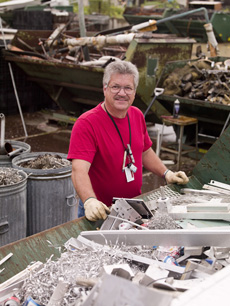
B. Todd Wagner - Material Specialist of the Property Inventory Department of the Business Services Section.
"The easiest and quickest way to do a job is not always the safest way. A lot of people might want to use the tool they have handy rather than the tool they really need. I tell them it's worth their time and effort to get the right tool. That stops injuries."
See all Fermilab Profiles in Safety here.
|
Fermilab dancers shine at Museum holiday event
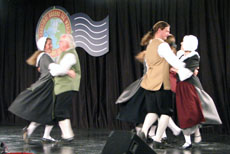
Members of the Fermilab International Folk Dance group perform on stage at the Museum of Science and Industry's Christmas Around the World and Holidays of Light event on Nov. 25.
Fermilab's International Folk Dancers usually practice on the old, wood floors of Kuhn Barn, but in late November, they danced on stage at the Museum of Science and Industry.
The group performed traditional Welsh dances in full, historical costume on Nov. 25 as part of the museum's Christmas Around the World and Holidays of Light. The event, which runs through Dec. 30, features cultural performances and Christmas trees decorated to represent the cultures of 50 different countries.
Mady Newfield, wife of MINOS experiment spokesman Rob Plunkett, has taught International Folk Dance at Fermilab for almost 20 years. She said the invitation, which was a first for this group, was an exciting opportunity for the folk dancers to show off their moves. The performers were hired by a Welsh performance group, the Cambrian Benevolent Society, to join in the Welsh dance performance.
To prepare for their performance, the international folk dancers practiced for months to memorize the movements and make their performance look effortless. "You need to be ready to perform from the sound of the first chord," said PPD's Doug Jensen, who helps lead both folk dance and Scottish country dancing at Fermilab. "You practice enough so that your body knows what to do even if your head doesn't."
Many of the dancers involved in International Folk Dancing also participate in Fermilab's Silk and Thistle Scottish Country Dancing group. Later this month, they will have a second chance to perform as part of the Royal Scottish Country Dance Society Chicago Branch Demonstration Team. The Silk and Thistle dancers have performed at the museum as part of the demonstration team every year for the last decade.
This year's Scottish dance will take place at 2:45 p.m. on Saturday, Dec. 15 at the museum. General admission to the museum is $11 for adults.
Jensen leads Silk and Thistle Scottish Country Dancing Tuesdays at 7:30 p.m. and Newfield leads International Folk Dancing Thursdays at 7:30 p.m. Anyone interested is welcome to attend or e-mail for more information. Dances last until 10 p.m., and afterwards many of the dancers spend time together at the Users' Center. "The group enjoys dancing together," said Newfield. "It's a very positive group and people want to come back."
-- Haley Bridger
|
Montage a rising star in
grid-enabled sky mosaics
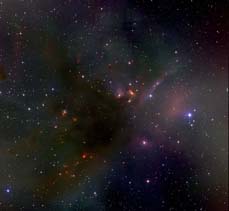
A three-color view of the Rho Oph dark cloud constructed with Montage from deep exposures made with the Two Micron All Sky Survey (2MASS) Extended Mission.
Image courtesy of 2MASS
Astronomers, like most people, are impressed by pretty pictures, says Bruce Berriman.
"We say 'wow,' just as the lay public does. But we approach images in a different 'light' than the public, so to speak. We want to understand the scientific content of the images, and the influence of the instrument and background on that content," Berriman explains.
Not all pictures are created equal
Berriman is an astronomer interested in high-end computing and is part of the team that developed astronomy application Montage.
Already adopted by eleven major astronomy projects, Montage is used to develop scientific data products and support astronomical research. A bonus is that many images produced are impressive enough to excite the general public.
A grid-based application, Montage allows astronomers to compare images taken from different projects using different telescopes and satellites and with different cameras, all while preserving the scientific content-the positional accuracy of the data and the intensity of light in the original images.
Read More
|
Missing matter caught in tangled cosmic webs
From USA Today, Dec. 10, 2007
Cosmologists are always complaining about their inability to find the dark matter in the universe, invisible stuff that's supposedly more prevalent than regular matter. They don't even know what it is, so of course they can't see it.
Meantime, a whole bunch of normal matter is missing, too.
A new computer model at least suggests where some of that missing normal matter might be.
Regular vs. dark
Regular matter - the "visible" atoms and molecules of dirt, people, stars, gas and dust - makes up only about 5% of the universe. Scientists call it baryonic matter, or baryons.
Dark matter is the term used to describe the invisible stuff that's holding galaxies together. Some 25 percent of the universe is dark matter, and it's all missing in action. The rest is even more mysterious, a sort of anti-gravity force called dark energy.
Read More
|
|
|
Does top choose the road
less traveled?
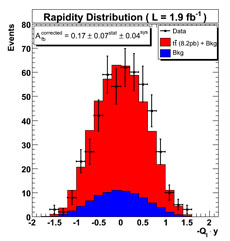
Rapidity distribution of the top quark production angle in the proton-antiproton rest frame. This analysis measures Afb = 17 +/- 7 (stat) +/- 4 (sys) percent, which can be compared to the theoretical value of 4 percent.
The top quark is now more than a decade old. With age comes a sense of comfort with the particle's place in the Standard Model, making it easy to forget how little is still known about the heaviest of quarks. The test of time alone is not enough to build confidence in our understanding of nature, but now, with more than 30 times the data that was used for its discovery, scientists at CDF are truly beginning to map out a complete picture of the top quark within the Standard Model. The CDF top group is pursuing a comprehensive set of measurements to fulfill this task.
As part of this mission, physicists at CDF seek to measure the forward-backward asymmetry in top production. This measurement, which looks to see if the top quark is produced preferentially in one direction, is a test of symmetries of the strong interaction. A large asymmetry in top quark production could be evidence of new physics in how the top quark is produced. The Standard Model theory, as it stands now, predicts a small asymmetry of roughly 4-6 percent.
The forward-backward asymmetry is calculated from the top quark production angle. Because the top quark cannot be directly observed, the top quark direction must be reconstructed from its decay products. Corrections are applied to account for any bias and/or dilution coming from backgrounds, the detector, event selection or the reconstruction algorithm. The result of the method is a value that can be directly compared to theory. Two groups of physicists at CDF have performed this measurement with similar techniques using two complementary variables. Both groups measure a larger asymmetry than predicted, though still within two standard deviations of the standard model prediction.
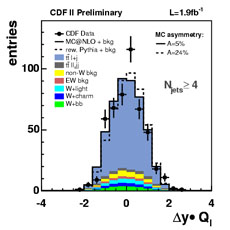
Delta-Rapidity distribution of the top quark producation angle in the top-antitop rest frame. This analysis measures Afb = 24 +/- 13 (stat) +/- 4 (sys) percent, which can be compared to the theoretical value of 6 percent.
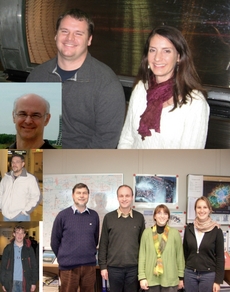
Top, from left to right: Dante Amidei, University of Michigan; Tom Schwarz and Robin Erbacher, University of California, Davis. Bottom, from left to right: Dominic Hirschbuhl, Thomas Peiffer, Thomas Muller, Wolfgang Wagner, Jeannine Wagner-Kuhr and Julia Weinelt, Universitšt Karlsruhe.
Result of the Week Archive
|
|
Have a safe day!
Monthly Leave sheets due Dec. 14
Monthly Leave Sheets are due in Payroll by 10 a.m. on Dec.14, 2007.
For Monthly employees who are on FTL, the Monday due dates remain. That is,
your due dates are Dec. 17, Dec. 24, and Dec. 31.
Monthly employees will be paid on December 21, 2007.
Project X physics workshop Jan. 25-26
Fermilab will host a second users' workshop Jan. 25-26 to discuss the physics of Project X. The workshop will focus on the details of the experiments which might be proposed to take advantage of a high-intensity proton source, their physics impact
and the development of the overall experimental strategy. Information about the
workshop, working groups and ongoing efforts is available online.
Wilson Hall maintenance
Ground floor maintenance work will continue through Friday, Dec. 14, in Wilson Hall. Painting, patching and re-carpeting of selected high-traffic public areas will be performed through Friday between 4 p.m. and midnight. Please do not disturb the repairs or equipment.
FNALU cluster meeting Dec. 19
There will be a general meeting for experimenters using
the FNALU cluster on Dec. 19 in Wilson Hall One West from 1:30 - 3:00 p.m.
The purpose of the meeting is get input from experiments on what
resources are needed and to identify experiments using FNALU.
Also the status of support and other changes to FNALU will be discussed.
EAP Office hours
The EAP Office will be open today and closed Friday, Dec. 14. Regular office hours will resume the week of Dec. 17. The EAP is available 24/7 by calling 1-800-843-1327 or online at www.vmceap.com.
New IT job descriptions
Open meetings for questions and answers will be held in Wilson Hall One West for employees affected by this process:
Thursday, Dec. 13, 9 - 10:30 a.m.
Friday, Dec. 14, 10:30 a.m.- noon
Monday, Dec. 17, 1:30 - 3 p.m.
Tuesday, Dec. 18, 9 - 10:30 a.m.
Wednesday, Dec. 19, 9 - 10:30 a.m.
Before attending, please review the presentation
Dec. 14 deadline for The University of Chicago Tuition Remission Program
The deadline for applying for the tuition remission program at The University of Chicago for the Winter 2008 quarter is Dec. 14. More information and enrollment forms. Contact Nicole Gee at x3697 with any questions.
Additional Activities |
|